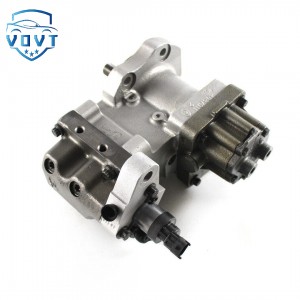Diesel Fuel Injection Pump 294000-0598 Engine Auto Engine Part
products description
| Reference Code | 294000-0598 |
| MOQ | 1 PCS |
| Certification | ISO9001 |
| Place of Origin | China |
| Packaging | Neutral packing |
| Quality Control | 100% tested before shipment |
| Lead time | 7~15 working days |
| Payment | T/T, Western Union, Money Gram, Paypal, Alipay, Wechat |
Design of an IoT-Based Remote Health Management System for Oil Pumps
Abstract
This study proposes an Internet of Things (IoT)-based remote health management system for oil pumps, aiming to achieve real-time monitoring, intelligent fault diagnosis, and predictive maintenance. The system architecture is divided into three layers: perception, edge computing, and cloud service. Multi-sensor data—including vibration, pressure, flow rate, temperature, and electrical current—are collected in real time through the perception layer. The edge computing unit performs noise filtering, feature extraction, and local anomaly detection, while the cloud platform conducts big-data analysis, fault classification, and remaining useful life (RUL) prediction using machine learning algorithms.
The system integrates time-series databases, data visualization dashboards, and cloud-based diagnostic models, enabling early warning of wear, leakage, cavitation, and other common pump failures. Communication between edge devices and the cloud is secured via MQTT over TLS with device-level authentication. Field testing results show that the proposed system improves maintenance efficiency, reduces unplanned downtime, and enhances operational reliability. This research provides a scalable technical framework for intelligent monitoring and lifecycle management of diesel and hydraulic oil pumps.
1. Introduction
Oil pumps are critical components in automotive, industrial, and hydraulic systems. Traditional maintenance approaches rely on manual inspection, which leads to delays in fault detection and inefficient operation. With the advancement of IoT and predictive maintenance technologies, it becomes feasible to implement real-time condition monitoring and data-driven decision-making for oil pump systems.
2. System Architecture
The proposed system is organized into three layers:
-
Perception Layer:
-
Multi-sensor data acquisition (pressure, flow, vibration, temperature, current).
-
Synchronization with engine control signals or injection pulses.
-
On-site signal conditioning and digitization using 24-bit ADCs.
-
-
Edge Computing Layer:
-
Preprocessing (filtering, denoising, resampling).
-
Real-time feature extraction (RMS, kurtosis, frequency spectra).
-
Lightweight fault detection models (SVM, 1D-CNN).
-
Local data caching and event-triggered transmission via MQTT.
-
-
Cloud Platform Layer:
-
Data ingestion and storage (Kafka + InfluxDB).
-
Fault classification and RUL prediction using machine learning.
-
Visualization dashboards, trend analysis, and alert management.
-
RESTful API and mobile application for remote access.
-
3. Key Hardware Components
-
MEMS or piezoelectric vibration sensors (up to 100 kHz bandwidth)
-
High-pressure transducers (0–200 MPa)
-
Micro flow sensors or differential flow meters
-
Temperature sensors (PT100 or thermocouples)
-
Current sensors (Hall-effect or shunt-based)
-
Industrial IoT gateway (4G/NB-IoT/Ethernet) with secure OTA update
-
Embedded power supply, waterproofing (IP67), and EMC shielding
4. Cloud Data Processing and Analytics
-
Real-time data ingestion via MQTT over TLS
-
Time-series storage and batch feature aggregation
-
Fault classification (Random Forest, CNN, XGBoost)
-
Anomaly detection (Autoencoder, Isolation Forest)
-
RUL prediction (LSTM-based hybrid physical–data-driven model)
-
Alert management with graded severity (Info / Warning / Critical)
5. Diagnostic and Predictive Framework
The diagnostic process consists of:
-
Data labeling under multiple health states (normal, wear, leakage, cavitation, seizure).
-
Feature extraction in time, frequency, and statistical domains.
-
Multimodal fusion of vibration, pressure, and current signals.
-
Fault classification and RUL estimation based on hybrid models.
-
Validation using test bench accelerated degradation experiments.
6. Communication and Cybersecurity
-
Secure communication via MQTT/AMQP with TLS encryption
-
Device authentication through X.509 certificates
-
Encrypted data storage (AES256 at rest)
-
Secure firmware updates and device management via OTA
-
Edge device tamper protection and integrity verification
7. Evaluation Metrics
-
Diagnostic accuracy ≥ 92%
-
Mean early warning time ≥ 2 hours before failure
-
System availability ≥ 99.9%
-
Data loss rate < 0.5%
-
Power consumption ≤ 5 W (edge device)
8. Implementation Roadmap
| Stage | Description | Duration |
|---|---|---|
| 0 | Requirement definition and prototype planning | 2–4 weeks |
| 1 | Prototype development and initial testing | 6–10 weeks |
| 2 | Bench validation and dataset collection | 8–12 weeks |
| 3 | Field pilot deployment | 12–20 weeks |
| 4 | Production rollout and continuous optimization | Continuous |
9. Conclusion
The proposed IoT-based remote health management system provides an integrated solution for real-time monitoring, intelligent fault diagnosis, and predictive maintenance of oil pumps. Through multi-sensor fusion, edge-cloud collaboration, and machine learning analytics, the system achieves significant improvements in reliability, maintenance efficiency, and operational safety. The framework can be further extended to injectors, hydraulic systems, and other precision fluid components.























